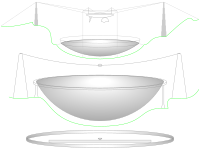RATAN-600
This article needs additional citations for verification. (November 2020) |
 View of the observatory from a neighboring hill | |
| Alternative names | Academy of Sciences Radio Telescope – 600 |
|---|---|
| Location(s) | Zelenchukskaya, Zelenchukskoye rural settlement, Zelenchuksky District, Karachay-Cherkessia, Russia |
| Coordinates | 43°49′33″N 41°35′11″E / 43.8258°N 41.5864°E |
| Altitude | 970 m (3,180 ft) |
| Wavelength | 1.38, 2.70, 3.90, 7.6, 13, 31.1 cm (21.72, 11.10, 7.69, 3.94, 2.31, 0.96 GHz) |
| Built | 1968–1977 |
| First light | 12 July 1974 |
| Telescope style | radio telescope |
| Diameter | 576 m (1,889 ft 9 in) |
| Collecting area | 12,000 m2 (130,000 sq ft) |
| Website | www |
| | |
The RATAN-600 (
Operating modes
The telescope can operate in three modes:[1]
- Two-mirror system: A sector of the ring focuses waves to the cylindrical secondary mirror which directs them onto the receivers.
- Three-mirror system: The linear plane mirror reflects the waves to the south sector of the ring, which focuses them on a cylindrical secondary, that reflects them onto the receivers. This is a Kraus-typeperiscope mirror system.
- Entire ring: For observations near the zenith, the entire ring can be used, together with the conical secondary mirror and its receivers.
Simultaneous independent observations at various discrete azimuths are possible. For this, a sector of the ring is coupled with one of the secondary mirror-and-receiver units, which can be positioned using railway tracks, while another sector, in conjunction with another secondary mirror, is similarly used for an independent observation.
Optical specifications
It has a resolving power in the horizontal plane of 1 arcminute at a wavelength of 8 cm (3.75 GHz). The effective collecting area of the entire ring is 1,000 square metres (11,000 sq ft) which is 0.33% of that expected of a completely filled reflector of this size.
Transit telescope

The RATAN-600 is primarily operated as a
SETI candidate signal
On 15 May 2015, at 18:01:15.65
Later research suggests that it might have been a faulty satellite in a slow spin, as the frequency matches one used for inter-satellite beacons,[citation needed] but was more likely to be the downlink from an intact but classified satellite.[5]
Gallery
-
Photo of the RATAN-600 in its environment
-
One of the conical secondary reflectors of the RATAN-600
-
Reflector plates, measuring 11,4 m × 2,0 m
See also
- Radio astronomy
- Five-hundred-meter Aperture Spherical Telescope world's second-largest diameter individual radio telescope
References
- ^ The RATAN-600 Radio Telescope – Russian Academy of Science, Special Astrophysical Observatory
- ^ Gilster, Paul (27 August 2016). "An Interesting SETI Candidate in Hercules". Centauri Dreams blog. Retrieved 2016-08-30.
- ^ Berger, Eric (29 August 2016). "SETI has observed a "strong" signal that may originate from a Sun-like star". Ars Technica. Retrieved 2016-08-30.
- ^ "Monitoring of the continuum of SETI candidates with RATAN-600 (SAO RAS official comment)" (Press release). Special Astrophysical Observatory. 1 September 2016. Retrieved 2016-09-01.
In the framework of this program, an interesting radio signal at a wavelength of 2.7 cm was detected in the direction of one of the objects (star system HD164595 in Hercules) in 2015. Subsequent processing and analysis of the signal revealed its most probable terrestrial origin.
- ^ "Sleuths Find the Top-Secret (And Classified) Satellite Behind Trump's Tweeted Photo". Space.com. 5 September 2019.




